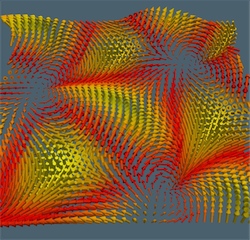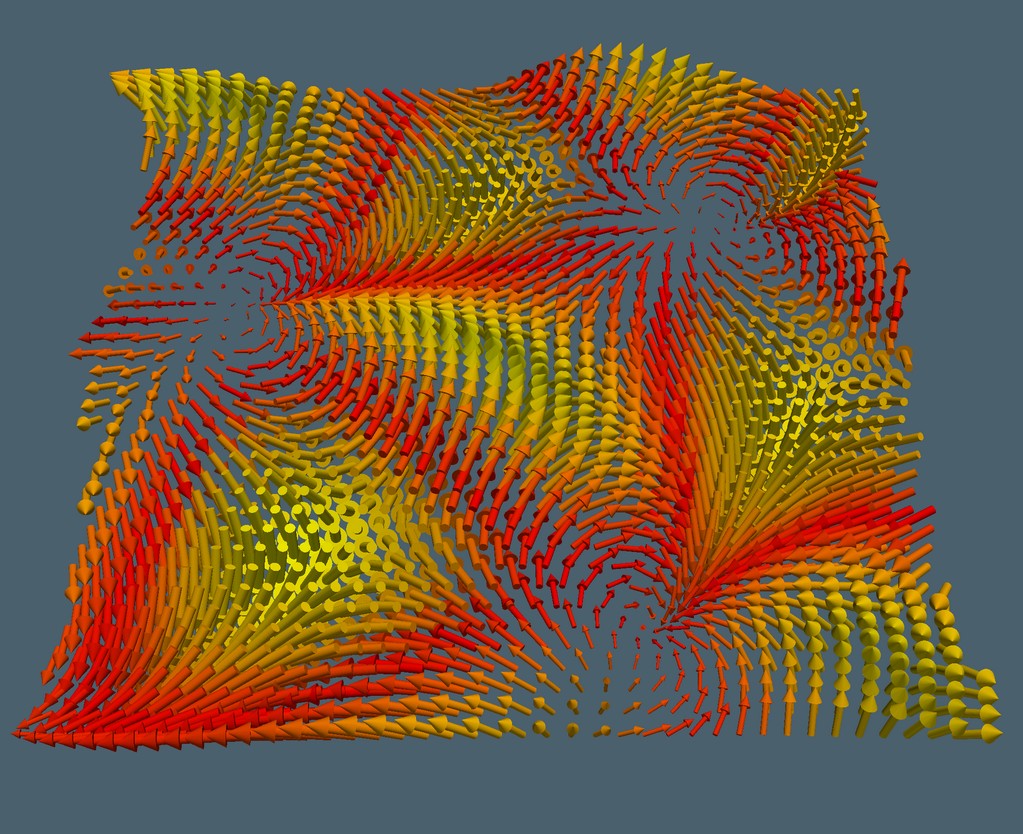Controlling a Condensate’s Texture
Quantum fluids such as superconductors and Bose-Einstein condensates (BECs) can contain tornado-like vortices that don’t go away with time. In the 26 November Physical Review Letters, Australian theorists show how to controllably make arrays of vortices and more complex structures. Since the flow patterns in these fluids are governed by simple mathematical rules that apply to other, very different physical systems, lab versions could give insight into analogous structures in magnetic materials, particle physics, or cosmology.
The molecules in a traditional fluid are randomly oriented, but there’s a class of fluids including liquid crystals and superfluid helium where there’s an underlying order. It’s characterized by a so-called order parameter, which takes on a value everywhere within the fluid and mostly varies smoothly from place to place. For example, in a liquid crystal, where the rod-shaped molecules tend to align with their neighbors, the order parameter at any location is the direction of the rods. In superfluid helium, the order parameter is a complex number representing the quantum state of the fluid at each point.
Properties as diverse as the strength of metals and the electrical resistance of superconductors are determined by “topological defects” in the underlying order–places where the order parameter changes abruptly in a way that affects the surrounding fluid. For example, a vortex in superfluid helium has tornado-like flow, but it’s also a topological defect. Like other topological defects, a vortex is mobile and persistent, like a knot that you can move around on a string but can’t easily eliminate.
Defects in very different physical systems should have similar behavior, as long as the mathematical nature of the order parameter is the same. Creating new kinds of topological defects under controlled conditions could lead to new insights into their properties. Gary Ruben, now at the University of Melbourne in Australia, and two colleagues from Monash University in Melbourne have proposed a way to make new types of topological defects in a controlled way in the lab.
Their proposal is based on a recently-demonstrated technique for creating vortices in a BEC, an ultra-cold cloud of atoms occupying a single quantum mechanical state. The first step is to divide the condensate into three pieces, in three separate laser traps arranged in an equilateral triangle. When the traps are turned off, the pieces begin to expand into the surrounding vacuum. As they overlap, the three pieces form an interference pattern. Instead of the classic stripes, or fringes, the pattern in the center is a honeycomb lattice of clockwise and counterclockwise vortices.
Ruben and his colleagues now extend this concept to condensates that contain two distinct components, such as atoms in two different internal configurations. The atoms in each state form a separate quantum fluid with its own quantum state at each point in space, so the order parameter consists of two numbers instead of one. The mathematical properties of this order parameter are identical to those found in very different physical systems and allows the formation of topological “textures” that are more intricate than simple vortices. One example consists of counter-rotating vortices in the two components, so the net fluid motion cancels. Similar defects have appeared spontaneously in other types of experiments but have never been deliberately created and controlled.
To create such structures, the researchers propose first illuminating the three trapped condensates with a laser. The laser fixes the relationship between the quantum states of the two atomic components, says Ruben, and the beam varies with position in a way that affects each piece differently. Once the traps are turned off, these relationships should determine how the two separate honeycomb patterns line up, letting experimenters create a variety of textures, including the counter-rotating vortices.
“This proposal is a pretty clever way to generate these textures, but it’s also building on things that have been well established in BEC research. What hasn’t been done [experimentally] is putting all these things together,” says Brian Anderson of the University of Arizona in Tucson. “Probably the most difficult part is in the detection stages,” to show that the whole procedure worked.
–Don Monroe
Don Monroe is a freelance science writer in Murray Hill, New Jersey.
More Information
Cosmology in the Lab, 2006 Focus story on searching for topological defects called cosmic strings in a lab analog
Nobel Focus: The Coolest Atoms, 2001 Focus story on Nobel Prize for the Bose-Einstein Condensate





